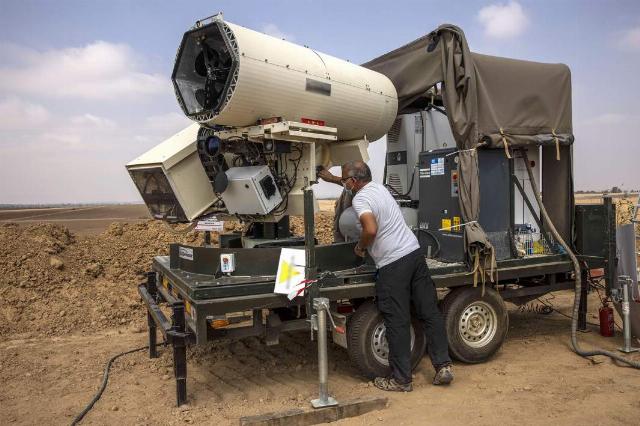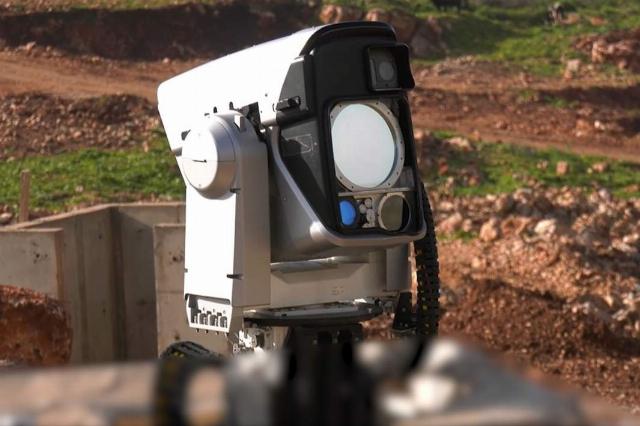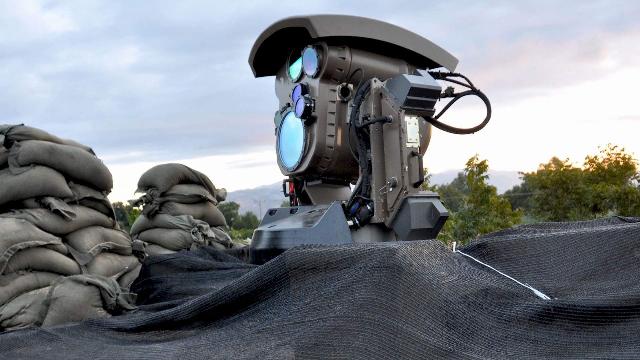Advanced developments are in a high state of readiness
Israel has completed 20 years of work on the creation of the Iron Ray laser system. Various countries around the world are working on this new type of weapon. Who currently has combat lasers, what capabilities they have, and whether these weapons can become the basis for combating UAVs, is in the Izvestia article.
What is the Iron Ray system?
The Israel Defense Forces has announced that 20 years of work on the creation of the Iron Beam /Or Eitan laser combat system has been successfully completed and deliveries of the combat laser to the armed forces of the Jewish state will begin by the end of this year.

Photo: AP/Tsafrir Abayov
Image source: iz.ru
Even during the military operations in May to repel attacks by Iranian missiles and drones, Israel used prototypes of the Iron Ray. The air defense system is capable of providing close-range interception of drones, missiles and mortar mines by hitting objects with laser beams. The principle of operation of the complex is simple in words: radars detect a target object, take it for escort, point lasers of a paired installation at the target, and within a short exposure the target is destroyed. The laser burns through the target object and either causes it to detonate or destroys it by thermal action.
The features of such a system are that it takes a little more time to hit a durable, thick-walled object such as a mortar mine than to hit a light drone, and all this time the laser beams must "guide" the object at a distance of hundreds of meters and kilometers. This became possible due to the development of electronics, precision mechanics, and, of course, laser technology itself.

Photo: Global Look Press/Idf Spokesperson
Image source: iz.ru
The duty cycle, apparently, is measured in seconds, and the power source is electricity. As a result, it turns out that the cost of hitting a target is measured literally in units of dollars and is not comparable to the cost of modern anti-aircraft missiles. In addition, lasers are great for countering the most modern challenge — a swarm of drones. Fighting it with modern air defense systems is not only expensive, but also difficult, and a laser installation can cope with a dozen drones, literally without leaving a place, due to the high rate of fire and the minimum operating cycle time.
What laser systems are being developed in the countries of the world
Many armies have already realized that lasers are the future in the confrontation with drones. The French defense agency DGA has ordered from a consortium of MBDA, Safran, Thales and CILAS companies a prototype of the SYDERAL combat laser system to combat drones by 2030. It is assumed that it will be designed for Navy ships, but technically it can also be used on land — in a mobile or stationary version. The tasks are the same as those of the Israeli system: intercepting missiles, mines and drones at short range — that is, as a line of self-defense.

Photo: IZVESTIA/Eduard Kornienko
Image source: iz.ru
During the Zapad-2025 exercises, Belarusian gunsmiths demonstrated the work of their Saffron laser complex to destroy quadcopter drones at a distance of up to 1 km. The specifications indicate that the target engagement time is less than 10 seconds, and the range of the system is up to 1.5 km: this completely covers the battlefield or a large infrastructure facility. The complex is mounted on an automobile chassis and is equipped with optical and radar surveillance systems with a target detection range of up to 4.5 km. Apparently, it can work not only on hovering drones, but also on aircraft-type devices. Belarusian engineers say that the Saffron is undergoing tests, after which it can be put into service. Further modifications for different types of chassis and further development of the technical solution may follow.
Three samples of laser systems were presented by the People's Liberation Army of China at a parade in Beijing in early September.

Photo: Global Look Press/Ethan Hunter
Image source: iz.ru
Among them was the LY-1 laser system. It is stated that it is capable of hitting ballistic and cruise missiles, but, most likely, tactical and operational-tactical products are meant, since more powerful systems are most likely required to defeat long-range missiles and their warheads.
Two models of laser installations were also shown, which are probably designed to destroy drones and drones. Slightly smaller dimensions of the warhead, smaller dimensions of the body of the installation itself, and therefore lower energy capabilities. In any case, it seems that China is starting to use combat lasers not only at experimental ranges, but also in the military. This is a very serious change.

Photo: RIA Novosti/Ministry of Defense of the Russian Federation
Image source: iz.ru
The Russian Armed Forces are also trying to keep up. It is our country that has an absolute priority in combat laser systems — back in the 1970s, experiments were conducted at the Sary-Shagan test site with lasers and missiles, and even spacecraft. Today, Russia is the only country in the world where the Peresvet laser systems are on duty and on active duty in the nuclear deterrent forces. Their task is not to shoot down missiles and satellites, but to make reconnaissance satellites and drones blind. The complex produces a "functional lesion", after which the reconnaissance vehicle will not be able to perform its task.
Work on the creation of laser combat systems that could hit drones and other objects is also actively underway. Back in the summer, there were reports of a laser system being tested in the area of the special operation, which could burn out drone cameras and destroy the devices themselves on approach to the target. It was stated that the range of the complex is up to 6 km. The details of the design have not yet been disclosed, but it is clear that once the system has been tested, it may soon go into mass production.
Dmitry Kornev
Roman Kretsul

